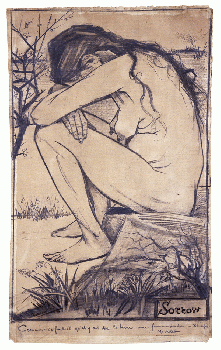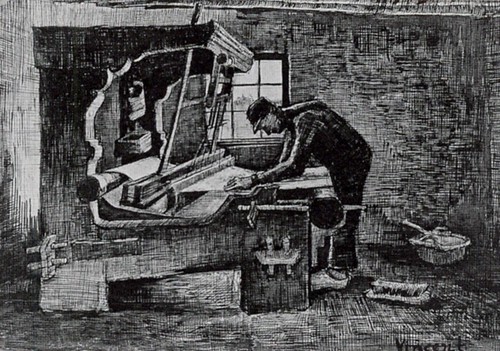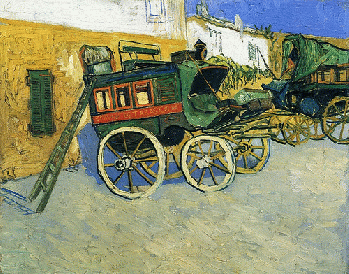by John Kendall Hawkins
"Books and reality and art are the same kind of thing for me."
- Vincent Van Gogh
In 1888, Vincent Van Gogh sold The Red Vineyard, a vibrant field of color abuzz with laborers, to an intimate supporter of the hungry artist for today's equivalent of $2000. These days, a single painting by Van Gogh can go for as much $66m at Sotheby's, and Van Goghà ? is a billion-dollar industry. And the topper is that The Red Vineyard, if sold today, probably would be the single most expensive painting ever bought, not because it was the most popular artist's best, but because it's the only one he ever sold in his lifetime. (Wow.)
Over the decades there have been a number of film accounts of Van Gogh's work and life, from Stanley Kubrick's Kirk Douglas-driven Technicolor slave revolt from Black-and-White, to the more recent BBC biopic, Painted with Words, starring Benedict Cumberbatch with a script derived solely from Van Gogh's written words. Most recently, an energetic account of his life and work was expressed by Loving Vincent (2017), which was the first fully painted feature film; a large team of artists were brought together to animate Van Gogh's paintings and tell his story, beginning a year after his death. (Definitely worth a watch, all of them.)
Like the story of the simple and honest Christ, whose spectacular legacy built majestic cathedrals and led to fugues and counterpoint, Van Gogh has taken on a second life that is a colossus compared to the intentionally humble, self-abnegating way he existed, often among the poor, and always at the subsistence level. It's no mere coincidence that he emulated the style of Christ, moved by an empathetic consciousness of being and seeing the sublime in the simple. Van Gogh would have understood completely William Blake's vision of "eternity in a grain of sand."
You would think that there's not really much more you could write about Van Gogh's life and work that hasn't already been covered by every facet of capitalist enterprise, from coffee-table books for the upper middle class, to fancy brushes for 'bohemian' wannabes who never get around to it, to dolls with detachable ears or sunflower dresses. Mariella Guzzoni may have found the last angle uncovered and details her findings in Vincent's Books: Van Gogh and the Writers Who Inspired Him. If Vincent had had his druthers, Guzzoni suggests, he'd have been a writer instead of a painter.
"It might be fair to say that literature and poetry were his ï ¬ rst love, preceding his development as an artist," writes Guzzoni. Van Gogh was bookish, thoughtful, and kept dutiful correspondence with his brother Theo and sister Willimena. He was as well-suited for writing as he was for painting, keeping albums full of poetry he admired, and producing highly polished letters to his siblings that sometimes included tiny detailed drawings of places he observed or of paintings he was working on.
Guzzoni notes that Van Gogh read extensively, across centuries of art and literature, and in multiple languages. Some of his favorite authors were Charles Dickens, Honore' de Balzac, Ã?mile Zola, Victor Hugo, Jules Michelet and Pierre Loti. Their themes, visions and energy were reflected in his work. Guzzoni remarks:
In the books he cherished most several themes recur: injustice and sympathy for the poor; the value of simplicity, humility and hard work; celebration of the land and nature; the examination of the human soul.
In addition, Van Gogh admired the great liberation from orthodoxy that books themselves represented: "... books and study are the means for every man to illuminate his way." And, at least mentally, dissolve class boundaries.
Vincent's Books contains seven chapters, each reflecting a transformative moment in his personal and artistic journey from a black-and-white world toward an Ezekiel-like glimpse into the sometimes phantasmagorical wheel of color to which we've become accustomed in Van Gogh's work--a journey into coal mines, the street life of Paris, the wide-open landscapes of Arles, and even a side dalliance into the mystical simplicity of Japanese art. "The seven chapters of this study explore Vincent's passion for books in its various forms - visual, conceptual, human - following a chronological thread," writes Guzzoni. She reminds us that Van Gogh had a relatively brief working life from age 16 to 37, twenty-one years during which he transitioned from art dealer to minister to artist, before he died of complications from a self-inflicted gunshot wound.
After returning from England in 1877, where he had worked as a teacher's assistant. Vincent returned to Holland when he was 24 years old, and, taking his parents' advice, accepted an offer to become a clerk at Blusse' & Van Braam bookshop in Dordrecht. Guzzoni writes that he "worked hard" in Vincent's own diary words: "I go there at 8 o'clock in the morning and come back at 1 o'clock at night." He was in a deeply religious phase of his life (1875-79), "during which time the intensity of his zeal would surge towards exaltation and even fanaticism," Guzzoni indicates. "His ï ¬ rst great passion exploded within him, overwhelming him body and soul: the evangelical passion for Christ.
"He saw the world through two main books: the Bible and Thomas à Kempis's Imitation of Christ."
Soon he left to live and minister among the coal miners of Berinage. He was deeply moved by the weight of their lives. Guzzoni quotes from a letter Vincent wrote to his brother Theo just before leaving for Berinage:
You surely know that one of the root or fundamental truths, not only of the gospel but of the entire Bible, is 'the light that dawns in the darkness'... those who work in darkness, in the heart of the earth like the mine-workers in the black coal-mines, among others, are very moved by the message of the gospel.
He longed to stay with them and preach, but his "zeal was not appreciated by the Evangelization Committee" and, after a short stint there, he was let go and in need of new work. Had the committee embraced him instead, the world might never have been gifted Van Gogh's art.
Rather than being discouraged, writes Guzzoni, Van Gogh moved to The Hague in 1881 and re-immersed himself in literature, absorbing the wisdom and knowledge and energy from eclectic scientific and cultural figures "Homer, Aeschylus, Job, Dante, Michelangelo, Rablais, Cervantes, Shakespeare, Rembrandt, Isaiah, Beethoven, but also Galileo, Newton." In addition, "he began to take painting lessons from the established painter Anton Mauve (1838-1888), his cousin by marriage and one of the founders of The Hague School." He was focussed on his reads of Dickens books, and during this time came across Sien Hoornik, a prostitute whom he wanted to marry in order to save her from destitution, into his home:
'A pregnant woman who roamed the streets in winter - who had to earn her bread, you can imagine how... I couldn't do otherwise', he wrote Theo in May 1882.
She became his live-in model, and though pleasant enough and companionable, she left his infatuation unrequited. Elaborating on his decision to Theo, writes Guzzoni, Vincent justified his saving gesture by quoting Jules Michelet La femme: 'How can there be on earth a woman alone - abandoned'. Sien became the despondent figure of Sorrow.
Guzzoni notes Van Gogh's fascination with The Graphic weekly newspaper, which was full of engaging drawings that accompanied news articles; artists were sometimes allowed to come up with the subject matter themselves and embroider their work with accompanying words. This suited Vincent, as he was in the vanguard of such illustrations in his correspondence. Not only did he collect every issue he could find, but found a way to purchase actual print blocks of drawing from the publisher. Writes Guzzoni,
The Graphic's new generation of illustrators, with their focus far from melodrama or caricature, really struck a chord with him. The most impactful images - very direct, sometimes close-ups - played on a duality: social realist themes and expressive power.
Guzzoni indicates that Van Gogh thought about making a living as a magazine illustrator. He was especially enthralled by Dickens's illustrator, George Cruikshank, who seemed to superbly capture the spirit and plebeian focus of the writer's work. One of Cruikshank's illustrations for "The Election of Beadle," in Sketches of Boz, became an inspiration for Van Gogh's The Poor and Money. In his work, Van Gogh traded in Dickens's election subject matter for: "a mass of people crowded around the gambling booth, trying their luck at the Dutch State Lottery."
A John Leech illustration, "John's Reverie," from a Dickens novel, The Cricket on the Hearth, also worked Van Gogh's juices of sublimation, becoming, for him, Worn Out. Guzzoni notes that while many artists were depicting tired workers with their heads in their hands at the time, only Leech gave them the cold comfort of sitting in their weariness next to a hot stove. This touching addition to the standard depiction stirred Van Gogh's evangelical core instincts.
Aside from Dickens, Van Gogh also began studying the work of weavers. This was partially the result of reading a commemorative piece on Mary Ann Evans (George Eliot) in The Graphic. There was a quote from Scenes from A Clerical Life that moved him. Guzzoni writes, "As a young boy, Vincent had loved that 'beautiful book by Eliot', as well as the reclusive weaver in Eliot's third novel, Silas Marner, The Weaver of Raveloe." The quote he read:
Every other cottage had a loom at its window, where you might see a pale, sickly-looking man or woman pressing a narrow chest against a board, and doing a sort of treadmill work with legs and arms.
Coal miners, fields workers, pressmen, prostitutes, weavers - all these laborers in the fields of Elysium (they don't own the mode of production) provided a kind of simple teleological principle at work: beautiful, honest, earnest. Van Gogh honored this industry with Weaver.
Guzzoni notes the extraordinary influence of the artist Jean-Franà §ois Millet, and Vincent relied on Alfred Sensier's biography, La vie et l'Ã...?uvre de J.-F.Millet (1881). Guzzoni wrote:
He felt in perfect harmony with the subject, not just on a theoretical level but also on a personal one. Millet's melancholic character, described by Sensier, was a revelation for Vincent. It was like looking in a mirror.
It became one of his favorite books and he carried with him everywhere, like bespoke catechism. Millet seemed to sum up his art and outlook on life:
In art there must be a governing thought expressed eloquently. We must have it in ourselves, and stamp upon others, just as a medal is stamped... Art is not a pleasure-trip; it is a battle, -a mill that grinds. I'm not a philosopher. I don't want to stop pain, or ï ¬ nd a formula which will make me indifferent or stoic. Pain is, perhaps, that which makes the artist express himself most distinctly.
No words, short of the Gospels, could have reached Vincent's heart more intensely. That's what's reflected in The Potato Eaters.
In 1888, closing in on the end of his life, Van Gogh went on the road to Provence "in search of new lights and colors," and carried with him Alphonse Daudet satires and romances, including Madame Chrysanthà ¨me, Tartarin de Tarascon, and Tartarin sur les Alpes to lighten his mood. In the latter book, Guzzoni surmises, Vincent was inspired by a Fre'de'ric Montenard illustration of the road to Tarascon he himself had only recently walked. Guzzoni offers more:
Leaï ¬ ng through Tartarin sur les Alpes... we encounter ... a watercolour [that] depicts a man walking along a very white road, a sprig of thistles in the foreground overlaying the scene boldly, three butterï ¬?ies whirling around it. " Although Vincent never mentioned this particular illustration in his letters, it must have inspired him, both visually and verbally.
The result of this inspiration comes in the form of Thistles.
Vincent's mood brightened briefly toward the end of his 11-year stint as a painter, along with his palette. The humor of Daudet's The Tarascon Diligence and its illustrations helped him produce The Painter on the Road to Tarascon (1888). And also, more importantly, the carriages he saw along the way. Guzzoni cites his excited letter to Theo:
'Do you remember in Tartarin the lament of the old Tarascon diligence - that wonderful page? Well, I've just painted that red and green carriage in the yard of the inn'
This must have been music to Theo's ears, as Vincent's The Tarascon Diligence was a cheering vision of his brother's recovery from a retroactively diagnosed bipolar disorder.
Guzzoni's chapter on when Van Gogh and Gaugin were housemates in the Yellow House in Arles in 1888 provides welcome dramatic tension to the book, as the two artists did not see thumb to thumb on most things aesthetic. Actually, the BBC production mentioned earlier, with Benedict Cumberbatch, does an excellent with their exchanges. They ate, talked - small and large - and painted side-by-side. Next to Theo, Gaugin was Vincent's most important social contact. As Guzzoni describes it:
Memory, imagination, dream; the simpliï ¬ cation of lines and bold use of colour were among the burning issues at the heart of their discussions in Arles, all falling inside the cauldron of 'abstractions'. The desire to go beyond the Impressionists and Post-Impressionists boiled in the blood of the boldest painters, and Van Gogh and Gauguin were at the forefront.
Vincent sought an art open to all, while Gaugin, says Guzzoni, catered to "a small elite."
Guzzoni closes out the volume with a chapter that ends where it all began - Vincent's love of reading. Studying was his way of keeping on, of finding vitality and energy cracked open in the words of others, a sustenance against the darkness that sought to drain him. At the end of his life he was in the care of Paul Gachet, a highly recommended physician. Guzzoni writes,
Vincent visited him frequently and painted at his home. In one of the two portraits he painted of his new physician we see two books, Germinie Lacerteux and Manette Salomon by the De Goncourt brothers, which the artist had brought the doctor.
Manette Salomon was one of his favorite books. He admired the aesthetic philosophy of the brothers, and was especially fond of the proclamations found in the Preface of Manette Salomon:
'We must demand the public's pardon for giving them this book and for warning them as to its contents. The public like ï ¬ ction; this is fact. They like books which deal with the fashionable world; this book is taken from the street.'
This opening gambit is a masterpiece of clarity, highly suitable for beginning a discussion with a new (if unfortunately rather melancholic) friend. These were the last books that Vincent painted.
The books are those on the table in the portrait, Doctor Gachet. Van Gogh used to wonder aloud with his doctor friend which of them was most melancholy. Van Gogh died shortly thereafter of complications from self-inflicted gunshot wounds after having a meltdown in Auvers-sur-Oise. His last words, according to Theo, by his side: "The sadness will last forever."
Vincent's Books brings a reminder that Van Gogh was an avid reader of books, who often wrote to his brother about his readings and their reflection in his work - if not always directly, then as emotional settings in which he placed his subjects. He did not see the painter's work as being different than that of a writer. Guzzoni cites a letter to Theo:
Zola and Balzac, as painters of a society, of reality as a whole, arouse rare artistic emotions in those who love them, for the very reason that they embrace the whole epoch that they paint. When Delacroix paints humanity, life in general instead of an epoch, he belongs to the same family of universal geniuses all the same. The goal was common; only the tool in hand changed, but not the verb itself, 'to paint'.
Guzzoni includes a selective chronology of his readings throughout his life, at the end of the book, which is helpful in imagining the shape of his responses to reading.
The ultimate value of this particular book is to remind us what an extraordinary ordinary man Vincent was. Writes Guzzoni, he would have preferred to be writer, and more than that a minister among the poor:
art was his third choice, and a humble occupation for which he never received much attention, let alone sales, in his lifetime.
Today, his simplicity of form and vivid representation of colors - the humanity with which he depicts down-and-outers and laborers which have made his work the common person's choice, also make him the darling of the 1%; Vincent never met a 1%er in his life: he might have been a one-man sweatshop so that they could make a buck off his soul for hundreds of years later.
A version of this article (without images) first appeared in Counterpunch on July 8. 2020.
(Article changed on November 12, 2020 at 21:45)











